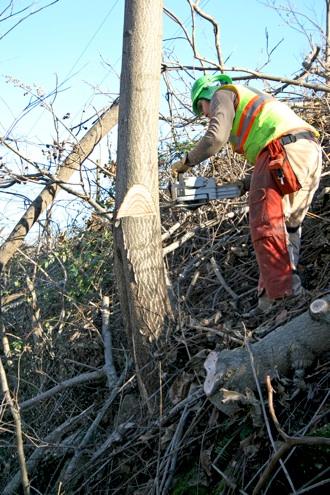While the main attraction is underground at Mammoth Cave National Park, there's quite a bit to see, enjoy, and learn from above ground at the Kentucky-based park. To preserve that setting, park crews are battling invasive trees that, if left unchecked, could pose a deadly threat to the native hardwood forests.
This fall the park has been working with the USDA-Mammoth Cave Resource Conservation and Development Council to continue the fight against invasives. Using federal road department funding, state materials, and equipment from the park, a team from the council has been conducting tree removal along several roads in the Mammoth Cave area.
“The focus will be on ailanthus, better known as the tree of heaven, and paulownia, also known as the princess tree,” said resource specialist Brandon Christie, who is leading the crew. “These two species of trees, which originated in Asia, are especially problematic because they smother out native hard wood species. Ailanthus even contains a chemical in its roots that inhibits the growth of other plants.”
The crews recently removed roughly 12,000 non-native trees from a 23-mile stretch of I-65 from south of Horse Cave to the Cumberland Parkway. Other exotic plants treated include privet, honeysuckle, multiflora rose, and kudzu.
“We cut down the trees, and then we treat the stumps using an herbicide that is similar to Round-Up," explained Mr. Christie. "The treatment we use doesn’t pose any risks because it is only viable for five to six hours after it is sprayed, but long enough to be effective.”
Removal efforts are now being focused on Highway 70 from Cave City to Mammoth Cave National Park and on Highway 90 from Cave City to Glasgow. The team will concentrate on 17 sites that have major infestations of ailanthus and paulownia.
“This will be an on-going project because these plants are persistent,” said Mr. Christie. "Within six months of treating some sites along I-65 the team found 80 percent regermination rates from seeds already hanging from trees when they are felled. Some spots will likely have to be re-treated every 3-5 years.
The cooperative project between the USDA-Mammoth Cave Resource Conservation and Development Council and the park will go hand in hand with Cave City’s efforts to plant dogwoods across the town. Dogwoods grow in the same general area as ailanthus and paulownia. Working to eradicate these destructive invasive species will blaze a trail for successfully planting and cultivating native hardwoods such as dogwoods, park officials said.




Add comment